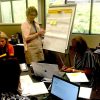In early August, the Johns Hopkins School of Education’s Center for Technology in Education held its inaugural Dynamic Impact Academy. Dynamic Impact — a five-stage, team-based continuous improvement process — has successfully guided state and local school leaders to analyze data through root cause analysis, select appropriate interventions, and monitor the quality and effectiveness of implementation in order to produce positive outcomes for all students. Academy participants included leadership teams from local school districts, educational consultants, and staff gathered to learn how to use the approach and improve outcomes for children of all abilities.
As part the training, participants were led through the Dynamic Impact ROOT protocol©_. This protocol provides processes for conducting a needs assessment to identify priority needs, and a root cause analysis to identify problems of practice. Two common techniques exist for conducting a root cause analysis: the 5 Whys, and the Fishbone Diagram.
The Dynamic Impact approach guided participants through a third method: the proprietary Triangle Technique©_. This technique guides teams through brainstorming and organizing ideas into relevant categories. Once ideas are organized, teams select the highest leverage category and summarize ideas into a root cause statement. The team validates the identified root cause by asking the following questions: Is the cause within your team’s control? Is the cause actionable? Does this cause make sense to someone else hearing it for the first time?
One of the team members who had previously used both the 5 Whys and the Fishbone techniques found she preferred the Triangle Technique©_; because, she said, the 5 Whys is a linear process that yields a narrower focus on possible causes, and the Fishbone Diagram does not provide enough guidance on next steps. She felt the Triangle Technique©_ was structured in a way that allowed the team to brainstorm many different causes, sort those causes into categories, and get a firm grasp on the direction they were headed.
After the Academy, another team member brought the technique to bear on a disciplinary problem at her school, it helped her and her team solve it, and her principal was well pleased. The Triangle Technique©_ had facilitated a productive conversation, and their team plans to use it regularly going forward.
The Triangle Technique© is one of many tools used in the Dynamic Impact approach. If you would like more information about Dynamic Impact, please contact Dr. Jennifer Dale [email protected].

